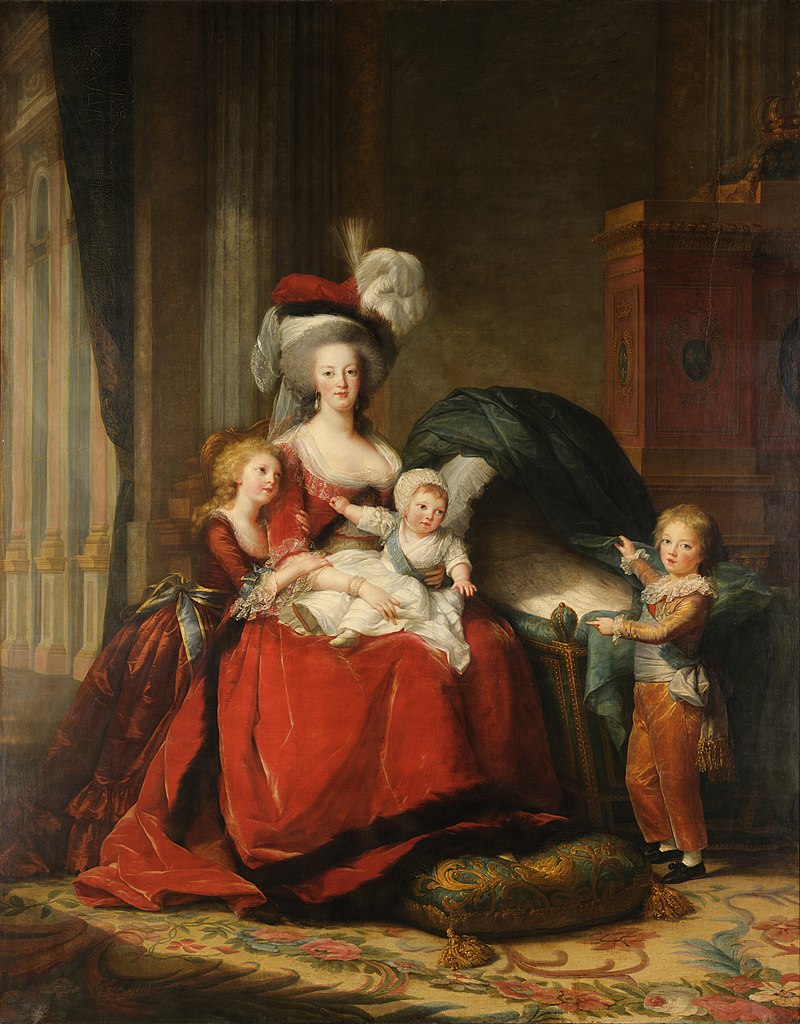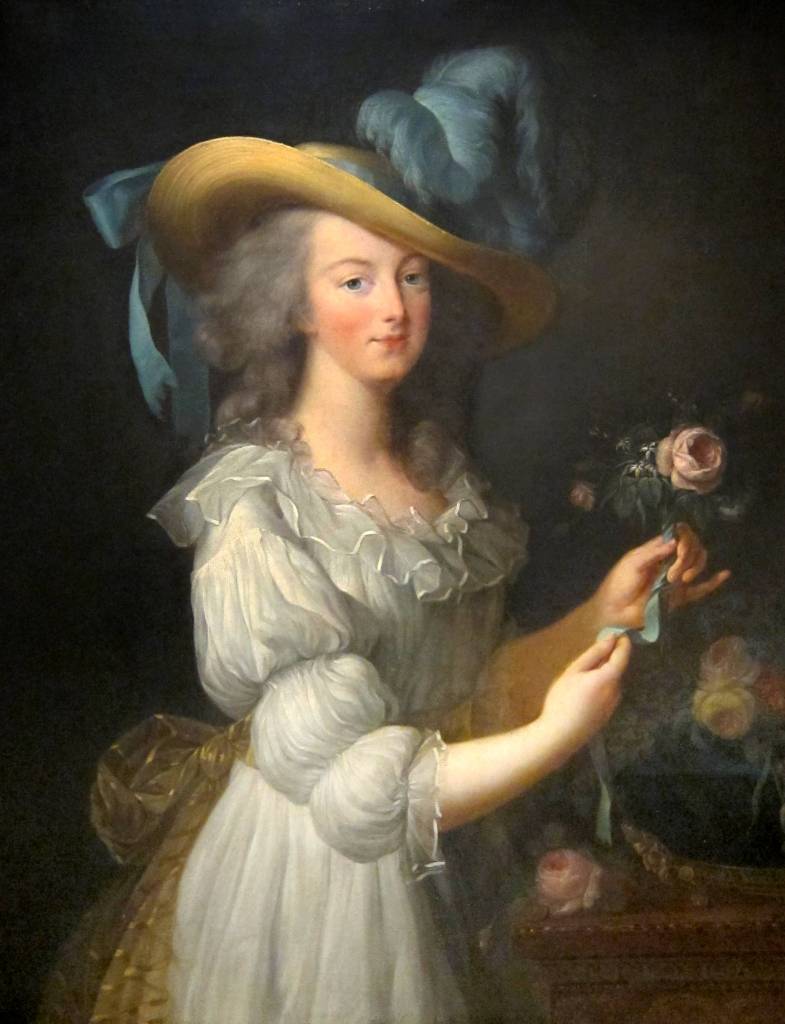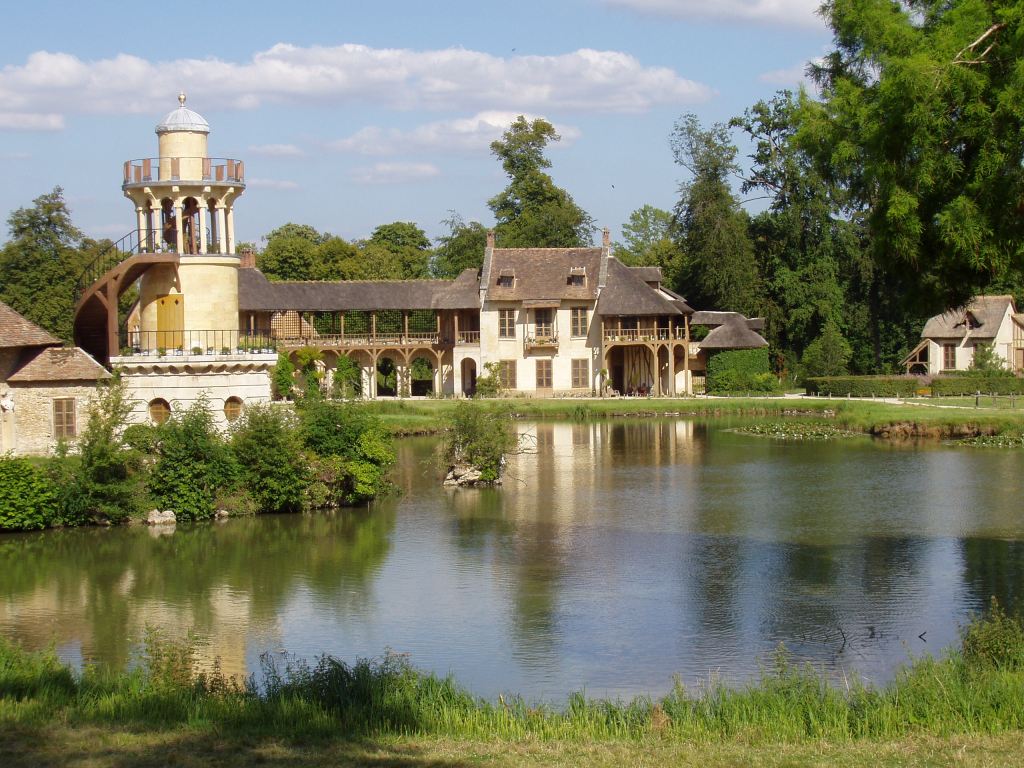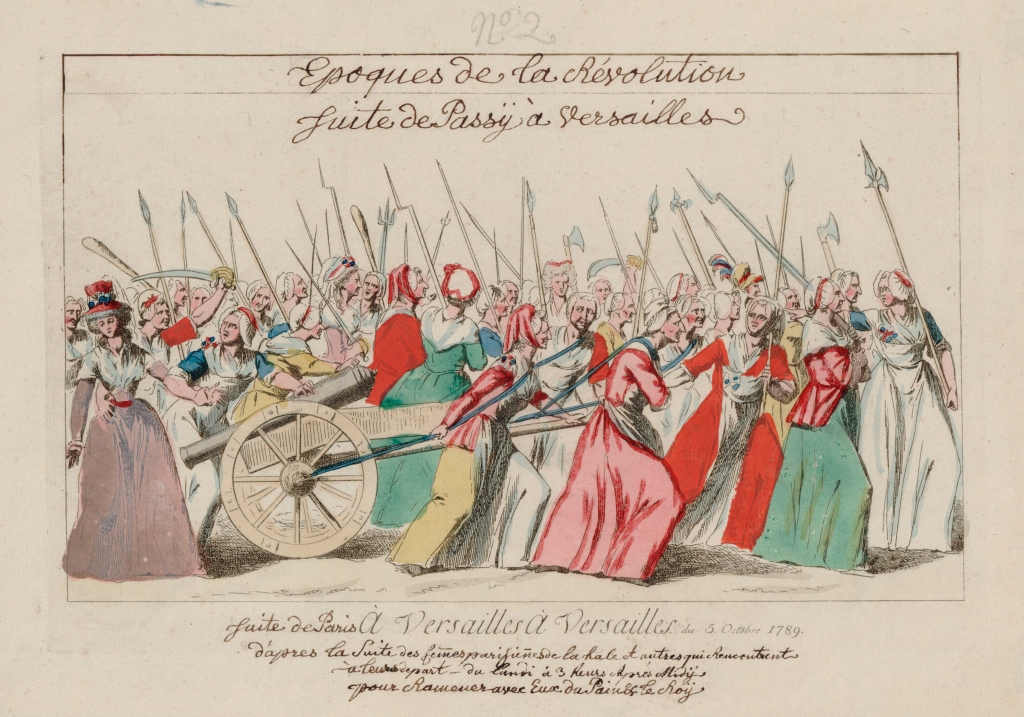Last week we left France shouting “the king is dead, long live the king,” which meant that 19-year-old Louis Auguste had just become Louis XVI, and 18-year-old Marie Antoinette was his queen.
The year was 1774, and things were difficult pretty much immediately. The harvest was poor that year and the price of bread doubled. In 1775, there were food riots (Hardman, Marie Antoinette, 54). Many an experienced king would have struggled with this, and the inexperienced Louis did too. Ministers rose and fell in a complicated mess of politics and personal malice.
Depending on which account you read, Marie Antoinette was either directly responsible for the ministerial chaos because Louis did whatever she told him to. Or she was not responsible because he refused to let her horn in on political matters (Fraser, 125). Or she was not responsible because she was too frivolous and air-headed to pay attention to politics.
Regardless of her interest or lack thereof, many people did not think Marie Antoinette belonged in politics, and one of them was her mother, Empress Maria Theresa, who wrote from Vienna to say, “If the state of this monarchy should get even worse I would prefer some minister to take the blame rather than my daughter” (Hardman, Marie Antoinette, 46). Which has to go down as one of the most ominously prescient statements in history.
Louis had plenty of personal problems. As I said last week, one author has suggested he had autism, but whether he did or not, there is no contesting that he was utterly failed by the adults in his life. He had zero training in domestic policy. The old king had never even allowed him to attend a council of state, for crying out loud.
He was, however, a hard worker and a great reader. He was particularly well informed about geography and English politics. He had read and admired all the Enlightenment writers, which is an odd choice for a man who had just become an absolute ruler leading by divine right in a country that still had serfs working in a feudal system. Nevertheless, his education had completely ignored a few other vital pieces of information.
The State of the Marriage
Full details on the state of the marriage were last week, but to bring you up to date, the happy couple were coming up on four years of wedded bliss, and it was widely believed (then and now) that they still hadn’t managed to do the necessary.
Not many would feel equal to the task of playing marriage counselor to royalty, which is maybe why it took so long, but one person who did feel equal to it was Marie Antoinette’s older brother Joseph. He also happened to be the Holy Roman Emperor, which put him on an equivalent rank with a French king. Anyway, he came for a visit in 1777. (We’re up to seven years of wedded bliss now, and no heir in sight.) Joseph took it upon himself to ask some extremely direct questions, and he reported the extremely explicit answers to yet another brother in a letter. The result of his investigation was that no physical impediment existed. But apparently no one had ever finished giving the birds and the bees talk to our king (now age 22). He was totally ignorant of one crucial step between desire and pregnancy (Hardman, Marie Antoinette, 55).
This is so hard to believe that some people do not believe it, pointing out that Joseph didn’t like his brother-in-law and may have been trying to make him look stupid (Hardman, Marie Antoinette, 58). The counterargument is that it is hard to argue with success. Something worked because within a couple of months Marie Antoinette was announcing her first pregnancy. With no other indication of what changed, many are inclined to think the socially inept Louis really was that socially inept. (I just have to put in that having your first child in your twenties is much healthier than having your first child at the age of fourteen, so the waiting may not have been all bad for Marie Antoinette. Just saying.)
When the baby was born, it was a girl. In other words, a disappointment. Then there was a miscarriage, and then finally in 1781 a boy, a dauphin, the French term for a crown prince, and it had only taken eleven years of marriage to get there. Marie Antoinette would go on to have four children in total: the heir, the spare, and two daughters. A perfect set, basically. Can’t ask for better than that.

The American Revolution
Around the same time the dauphin was born, the battle of Yorktown over across the pond was a huge relief, not just to the Americans, but also to Louis personally. The French government had been footing the bill for the Yanks’ Revolution since shortly after Louis took to the throne. The plain fact of the matter was that no matter how brave and heroic George Washington and the rest of the founding fathers were, war is far more expensive than the Americans could pay for. France was hemorrhaging money on their behalf, and Louis knew it, though his people still didn’t.
You might wonder what was in it for France, and indeed that is a good question. Later, Louis would say that his ministers had taken advantage of his youth (Hardman, Louix XVI, 93), and it is certainly true that he was young. Just 21 when the commitment was made. This is not a podcast episode on him, so I’m gonna oversimplify a little here, and paraphrase the discussions that led to French involvement. They basically ran along the lines of: Supporting the Americans? 1.5 billion francs (Hardman, Marie Antoinette, 76). Showing the English where they can shove it? Priceless.
The one person who was definitely not responsible for that enormous expenditure was Marie Antoinette. If she had been consulted, she would have preferred France to support her brother Joseph in his ongoing battles on the Continent. Joseph wrote to her regularly to berate her for not accomplishing that. What, after all, was the point of sending their Austrian princess into France if not to get stuff like that done? But Louis wasn’t going to his wife for political advice. She was ashamed to have to write Joseph back that she could not do as he asked. Louis, she wrote, “is naturally taciturn and it often happens that he does not talk to me about matters of state even when he has no desire to hide them from me…. When I reproach the King with not having spoken to me about certain matters, he is not upset, he appears a little embarrassed and sometimes he replies naturally that he never thought of it” (Hardman, Louis XVI, 96).
The Versailles Household Budget
If Marie Antoinette had no political role and for a long time had no maternal role either (Fraser, 126), it is fair to ask what she was doing with her time. Well, she was doing the only thing left to her: she was having a good time.
She redecorated the Trianon (her own personal palace). She doubled the number of horses in her stable at a time when people across France could not afford bread (Hardman, Marie Antoinette, 54). She borrowed some of the crown jewels and neglected to return them appropriately (Hardman, Marie Antoinette, 98). She played cards and gambled for high stakes (Hardman, Marie Antoinette, 59). She gave lavish presents to those she liked, some of whom were not sufficiently high-born to deserve lavish presents. Tsk, tsk.
There is indeed a reason why she gained a reputation as a high maintenance wife. But she was far from the first French royal to overspend the household budget, yet the dislike of her was far out of proportion to the amount she spent. She might well have thought that economizing was pointless because even when she tried to tone things down, she got no credit for it. For example, when she discarded the highly formal silk dresses for cheaper and looser flowing muslin dresses, the public reaction was that she (a) ruined the silk business based in Lyons, France, and (b) looked like she was going around in her underwear. (Hardman, Marie Antoinette, 26). If you remember episode 10.7 on Elisabeth Vigée LeBrun, you may recall that her portrait of Marie Antoinette with a rose had to be hastily taken down for all the sniggering.

Then there were the staffing problems. By the time Marie Antoinette managed to have children, the French had discovered that childhood was something more than just a stage to suffer through. Hands-on parenting was now the fashion. See episode 11.2, The Discovery of Childhood, for more on that. Marie Antoinette was eager to be a hands-on parent, not that you would likely recognize it as such. Hands-on meant she spent part of each morning with her children, always with staff on hand for the icky bits. Your modern helicopter parent is not impressed. But it was far more time than her own mother, Maria Theresa, had ever spent with her.
Even so, the staff was upset about job security. When I say staff, you need to think big. Besides the governess (a high prestige job), there were two to four subgovernesses, plus wet nurses, dry nurses, a doctor, ten lady’s maids for the oldest princess alone, plus two male valets, whom Marie Antoinette observed had absolutely no responsibilities whatsoever. All of these people cost the crown money (for example, 1200 francs a year to the woman whose only job was to fasten the princess’s collar each morning). All of these people were spoiling the children in the hope of future favors.
Marie Antoinette decided to dismiss seven of them, which if you do the math, still leaves a small army of childcare workers, but the blowback was fierce. How dare this Austrian interloper dismiss women of good character who had served the royal family of France for generations! (Hardman, Marie Antoinette, 90-94)
The Infamous Necklace Affair
The expense that caused Marie Antoinette the most PR damage was the one that she had absolutely nothing to do with. Way back before the previous king had died, the court jeweler Boehmer had made an enormous necklace of 647 diamonds. It was valued at a cool 2 million francs. Only Boehmer was an idiot because he did it hoping, but not knowing, that Louis XV would buy it for his mistress. Then Louis XV died, and the only people who could possibly have sprung for it were Louis XVI and his wife Marie Antoinette.
Unfortunately, Marie Antoinette didn’t want it. Styles had changed, and it wasn’t yet retro, and she wasn’t going to wear it. She herself said the money would be better spent on a new battleship. (That is to say, she argued for the fiscally responsible decision, but did she get credit for it? No.)

The queen advised Boehmer to break up his precious necklace and sell the stones separately, which sounds remarkably like sense to me (Hardman, Marie Antoinette, 98-99).
Did I mention that Boehmer was an idiot? He didn’t take his queen’s advice. Even with bankruptcy looming, he kept on hoping Marie Antoinette would change her mind, so imagine his delight when she did. He knew she had changed her mind because the cardinal de Rohan told him so, only she was using Rohan as a go-between because she was afraid to tell Louis about the expense. (Admittedly, she had hidden expenses from Louis before, but only with a much, much smaller sum at stake (Hearsey, 83).)
Rohan said that if Boehmer would hand over the necklace to Rohan now, Rohan would get it to the queen, and the queen would pay for it by installments, starting in July.
You, I hope, are not an idiot, so you might be just a tad suspicious of Rohan, and there you would be wrong. Rohan was also an idiot. The real criminal mastermind was a woman named Jeanne de Valois. She had convinced Rohan that she was a close friend of the queen. Also that he, Rohan, was a fine figure of a man who set the queen’s heart all a-flutter. Public acknowledgement was, of course, impossible. Even private meetings were too risky. But a hot and steamy letter telling Rohan just how special he was? That she could do.
Jeanne de Valois had forged over 100 of these letters by the time Boehmer gave the necklace to Rohan, who gave it to Jeanne, who did not give it to the queen, but to her accomplices who did what Marie Antoinette had said should happen to it all along: They hacked it to pieces and sold the diamonds individually. What a great idea!
If either Boehmer or Rohan had been thinking with their brains instead of their … personal insecurities, they would surely have realized that the queen didn’t sign anything as Marie Antoinette de France, as had been written by the forgers. She signed as just Marie Antoinette. Everyone in Europe knew who she was. No further identification was needed.
When Boehmer and Rohan finally realized that the queen was not wearing her new necklace, and she had no intention of paying any installment in July, the panic set it. Rohan wanted to pay for the necklace himself in order to keep it all quiet, but he didn’t have that kind of money. So in the end, both men, gibbering with fear, had to throw themselves on the mercy of the king and queen, admitting that yes, they were all kinds of pathetic, but they were not criminals (Hardman, Marie Antoinette, 102).
What followed was an enormously public trial. The forgeries were obvious, so official blame was assigned exactly where it was deserved: on Jeanne de Valois and her accomplices. But unofficially, most people walked away with the gut conviction that somehow, some way, Marie Antoinette was in on the heist. The story fit so well with all of their negative conceptions of her, How could she not be guilty? So despite the fact that she was as much a victim here as anyone else, the necklace affair would continue to dog her for the rest of her life.
Why the French Hated Her
The criticisms of her were ramping up, and not all of them were financial. It was common knowledge for example that in the hot summer evenings, the queen like to walk out in the grounds with her friends. Clearly, a lesbian orgy was going on. Also, she bathed in the blood of French people. The tabloids said so (Fraser, 457).

You might wonder (and I’m sure she wondered) why the French were so determined to hate her. But several things were different since the last grotesquely extravagant French monarch. For one thing, she was a foreigner, and a dirty Austrian at that. (Actually, Marie Antoinette did have French ancestry, but she was born in Vienna, and that apparently makes all the difference.)
For another thing, the French were now aware that kings don’t necessarily rule by divine right. A host of best-selling philosophers had told them so. Plus the English (whom we hate as much as the Austrians) were tripping along with a constitutional monarchy. You know, the kind where there are actual limits on their powers. And hadn’t the Americans just won a war saying they didn’t need even a constitutional monarchy?
All of that probably wouldn’t have mattered without the financial crisis. The plain fact was that the French government hadn’t turned a surplus since 1738 and the current Louis hadn’t even been born yet then. Since divinely appointed kings don’t have to do transparency, the public didn’t know the state of the finances. Plus the tax base was all wrong. Peasants paid more than they could afford while the clergy and nobility barely paid at all. The monarchy had been objecting to this since 1748 (also before the current Louis was born). But even king who rule by divine right face barriers when they get between rich people and their money, so nothing had changed.
In 1781 finance minister Jacques Necker had attempted to ease public fears by consenting to transparency, and for the first time in history French people got to see how their government spent their money. Only it turns out that what Necker called transparency was actually just the illusion of transparency because his goal was to calm everyone down. He cooked the books. He neglected to include the cost of the American war in his published accounts, so it looked like everything was fine, when in fact, it was not.
Since Necker had said everything was fine, the people couldn’t understand why only a few years later Louis is coming to them, asking them to pay more taxes. Where had all the money gone? Clearly, someone was spending money at an unbelievable rate, and obviously, that person was the queen, what with her diamond necklaces, and her wardrobe, and her gambling, and her palace, and her little hamlet where she could pretend to be a peasant. That last sounds condescending in the extreme, and it was. But it wasn’t Marie Antoinette’s original concept. It was fashionable at the time. Many rich people built little hamlets where they could enjoy being the cleanest, best fed, and least worked peasants in France.

There is no denying that Marie Antoinette was extravagant. But a quick look at the numbers shows just how much this anger was misplaced. Even that ridiculous necklace that Marie Antoinette did not buy cost only about 0.15% of the American war (Hardman, Marie Antoinette, 76, 98). She could have dressed in nothing but sackcloth and ashes and gone nowhere but to confession. It would not have made any appreciable difference to the looming financial ruin.
So let me be just one of many Americans to say to France and Marie Antoinette in particular, thanks? Worked out great for us. So sorry it wasn’t mutual. Yeah, okay. Not sure what else to say. Moving on.
Belatedly, a Loving Marriage
It is along about this time that the relationship between Louis and Marie Antoinette really comes into its own. As related last week, neither of them had any choice about the marriage, they were super young when it started, and both had struggles that in the modern world might well have merited a diagnosis (ADHD for her, autism for him). This was no great romance in the traditional sense. But it was, nevertheless, a marriage of devotion, loyalty, and (in its own way) love.
Louis, who adored maps and struggled with people, went to council every day to argue for new taxes. Every day he came back to his wife in tears. It was an impossible task, and he was just not the right man for the job. He began to suffer a nervous breakdown, visibly retreating into himself, while Marie Antoinette struggled to fill in the gap. We have, for example, her revisions on his speech to the Estates-General (Hardman, Marie Antoinette, 171).
While financial ruin loomed, and the arguments went on and on, the king and queen had personal tragedy too. Two of their four children died, including the dauphin, who had always been sickly. The spare was shoved in as the new dauphin.
The Beginning of the End
There was no time to grieve. In the Estates-General, tempers had reached a boiling point. The situation was so explosive that troops were summoned because it was believed that the city of Paris might rise up and attack the king’s residence at Versailles. It was a valid fear, but a PR mistake because the city of Paris was afraid the troops had been called so that Versailles could attack Paris (Hardman, Marie Antoinette, 181).
Meanwhile, the ministers suggested the royal family should flee. Marie Antoinette packed. But in the end Louis could not decide whether to go or not. (It was obviously dangerous to stay, but if he left, it would leave a vacuum. And who would fill the vacuum? There was no shortage of dangling family members who were sure they could make a better job of being king than he could.) While he vacillated, Marie Antoinette sent her friends away. The mass exodus of France’s most rich and glittering had begun.
On October 5, 1791, a horde of Parisian women marched on Versailles in a story I hope to some day tell in a series called Women on the March.

For today, I will just say that Marie Antoinette was flat out told it was time to run. Like, now. But Louis was out hunting, and she point blank refused to go without him. (I told you there was devotion there.) By the time Louis was found and brought in, it was too late. The standoff lasted all night, and at daybreak the mob broke in. They made for the queen’s apartment and killed her bodyguards.
In terror, Marie Antoinette fled through the secret passage that led to the king’s apartments, but the door on the other end was locked. She banged on it for ten minutes before it was opened, and allegedly her hair went white from the fear (Hearsey, 218), a condition which is still known as Marie Antoinette syndrome.
The mob demanded the royal family go to Paris, and they did. As prisoners. They traveled in a carriage while the crowd carried the heads of their bodyguards on pikes beside them. It was a seven-hour journey and in all that time Louis did not utter a single word.
Selected Sources
Fauchard, Pierre. Le chirurgien dentiste. France: Chez Jean Mariette, 1728. https://www.google.com/books/edition/Le_chirurgien_dentiste/BjBSAAAAcAAJ?hl=en&gbpv=0
Faÿ, Bernard. Louis XVI, Ou, La Fin d’Un Monde. Translated by Patrick O’Brien, London, W.H. Allen, 1968.
Fraser, Antonia. Marie Antoinette : The Journey. New York, Ny, Anchor Books, 2002.
Hanley, Sarah. “Configuring the Authority of Queens in the French Monarchy, 1600s-1840s.” Historical Reflections / Réflexions Historiques 32, no. 2 (2006): 453–64. http://www.jstor.org/stable/41299380.
Hardman, John. Louis XVI. New Haven, Conn Yale Univ. Press, 1993.
—. Marie-Antoinette : The Making of a French Queen. New Haven, Yale University Press, 2019.
Hearsey, John E N. Marie Antoinette,. Sphere Books, 1972.
Imbler, Sabrina. “Marie Antoinette’s Letters to Her Dear Swedish Count, Now Uncensored.” The New York Times, 1 Oct. 2021, http://www.nytimes.com/2021/10/01/science/marie-antoinette-letters.html.
Jefferson, Thomas. Autobiography of Thomas Jefferson, 1743-1790: Together with a Summary of the Chief Events in Jefferson’s Life. United Kingdom: G.P. Putnam’s Sons, 1914. https://www.google.com/books/edition/Autobiography_of_Thomas_Jefferson_1743_1/5lG7ISgjvr0C?hl=en&gbpv=0
Nancy Bazelon Goldstone. In the Shadow of the Empress : The Defiant Lives of Maria Theresa, Mother of Marie Antoinette, and Her Daughters. New York, Little, Brown And Company, 2021.
Padover, Saul Kussiel. The Life and Death of Louis XVI. D Appleton-Century Company, 1939.
Sanson, Henri. Memoirs of the Sansons, from Private Notes and Documents. 1689-1847. United Kingdom: Chatto and Windus, 1876. https://www.google.com/books/edition/Memoirs_of_the_Sansons_from_Private_Note/ZZdIAAAAYAAJ?hl=en&sa=X&ved=2ahUKEwjkstSj-aWFAxWEAHkGHYylC0AQiqUDegQIDRAG
Timms, Elizabeth Jane. “When Mozart Met Marie Antoinette?” Royal Central, 5 July 2020, royalcentral.co.uk/features/when-mozart-met-marie-antoinette-133508/.

I would LOVE to hear about the Women’s March from you. Also, that necklace is HIDEOUS. Just by looking at it, I can tell the dude is an idiot.
LikeLike
Ooh, I’ll consider that the first vote cast for the Women on the March series!
LikeLike
[…] Last week we left Marie Antoinette in the year 1789, as she and her family were carted out of their home in Versailles and taken to Paris, with the heads of their bodyguards traveling beside them on pikes. […]
LikeLike